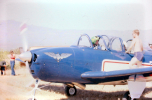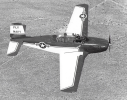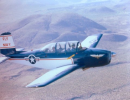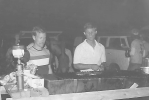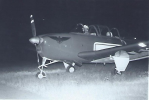and I sure don't - but my gas offload was exceptional.Who needs a chamber to do that?
-
Please take a moment and update your account profile. If you have an updated account profile with basic information on why you are on Air Warriors it will help other people respond to your posts. How do you update your profile you ask?
Go here:
Edit Account Details and Profile
You are using an out of date browser. It may not display this or other websites correctly.
You should upgrade or use an alternative browser.
You should upgrade or use an alternative browser.
Random Griz Aviation Musings
- Thread starter Griz882
- Start date
No, to the AF's credit it was far more sophisticated that what I remember as a young Ensign in Pensacola.
There were some cog skills tests at 25,000 feet and unlike what I remember of my Navy pressure chamber ride, they wanted to see you go into full symptoms of hypoxia before you were allowed to "recover".
Keep in mind what you did as an Ensign isn't the same as actual N1/NP1 or R2/RP2 training rides. The API rides were like a "My First Chamber Ride" for lots of unknowns. The Class 1 and 2 rides can be a little more in depth. When I went through the API ride, it seemed like if you thought about the word "hypoxia," you had to put your mask back one, but when I went through as a R2, we could go as long as they would safely allow on the time limit.
I really appreciated going as long as you could, as my symptoms were the same as in API (ironically, asymptomatic other than mental lethargy), but I got to try and fight through them longer to really see how they were affecting me.
Lastly we did an explosive decompression at 18,000' with emergency mask donning and O2 regulator settings moved to EMERG and positive pressure breathing introduced.
Again, this was standard on the R2/RP2 rides I did (although I want to say it was from 20K', but I may be misremembering). But I agree, it's a great exposure.
When I did the "fly the simulator with hypoxia" ROBD ride a few years ago, I want to say mine got way down to 50-60 (lower than they meant, ha ha). The Navy had just started doing those in the wake of the OBOGS/physiological episode scandal.Should have brought a pulse-ox with you. Be curious to see how low it went.
The profile I flew was a standard course rules departure into an ILS, about 10-15 minutes. The AMSO was there with the machine and reading off the saturation numbers and the sim guy was there to run the sim. I remember getting kind of a brain fog and graying out but the profile and procedures were so second nature that I flew the plane well enough that I didn't crash the sim. What I remember most was the feeling of physical distress, not just the confusion and sweating a bit but a really bad feeling. Funny thing was I blacked out right before touchdown, perfect timing because I must have put a bit of a flare in (and not crash the sim...), right as the doc announced the latest number and spun the control knob the other way so I could get oxygen again. I came to a couple thousand feet into the roll, still confused but not so bad that I couldn't remember to hit the brakes and bring it to a stop on the runway.
All good fun, especially how they let me get a bit lower than they meant, fun not crashing the sim too (booyah!), but the physicality of it really stuck with me. I don't remember that from the API chamber ride at all.
At the time, the Navy aeromedical and aviation physiology commuting was figuring out a ton of stuff about how your body gets oxygen to your brain and how all those processes work with the equipment in Uncle Sam's aircraft. That extra work going on was part of the OBOGS fallout.
(ROBD is the thing that dilutes your breathing air with nitrogen. That simulates some high altitude effects by reducing the partial pressure of oxygen in your lungs.)
It was a pretty great experience that built a lot on the chamber ride and four-year recurrent survival/physiology training. I have the VT-J instructors/Kingsville and Meridian JOPA, who collectively put their foot down in the spring of 2017, to thank for it.
I started flying when I was 17. Attended college in an aviation program so I had plenty of confident adventuresome YOUNG pilot friends. With no training and usually little to no briefing, we flew formation, had tail chase competitions, spot landing and short take off contests, and conducted surprise aerial water balloon attacks. We had a couple dirt strip we would fly out to for such shenanigans. We would organize boondocker campouts with fly in aircraft and dedicated ground support. Guys would load their apartment refrigerators into the back of pick ups to keep cold beer and kegs in, generators, large grills from 55 gallon drums, even had some friends that were competition sky divers, they would jump for free rides and give us a show. My recruiter would fly out the T-34B and do some decidedly non SOP things like form with low time civ pilots, and night take off from an unlit desert strip. Least you think it was a avgas fueled sausage fest, we had a few female pilots and sky divers. Girl friends were invited and the local Delta Gamma sorority always enjoyed the party.
Inspired by @HeyJoe recent photo scanning, I have tried to find some of the old pictures. Unfortunately, my slide scanner is not as good as his. Taken with an old manual exposure 35 mm, often shot through Plexiglas aircraft windows these are not art. And some are just plain dirty or damaged. Still they tell of story of my early years as a pilot. Never was much for big iron, IFR, simulators, or pressurization. I’ll post some of the military pictures in the appropriate thread later.
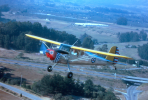
My wingman on arrival to the Watsonville CA Fly In, 1978
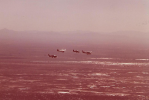
1977. Th so called Killer Bees, because of our swarm like formations, in cruise over SOCAL.
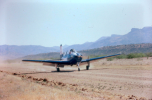
My recruiter lands the CNRC T-35B at our Boondocker location.
Inspired by @HeyJoe recent photo scanning, I have tried to find some of the old pictures. Unfortunately, my slide scanner is not as good as his. Taken with an old manual exposure 35 mm, often shot through Plexiglas aircraft windows these are not art. And some are just plain dirty or damaged. Still they tell of story of my early years as a pilot. Never was much for big iron, IFR, simulators, or pressurization. I’ll post some of the military pictures in the appropriate thread later.

My wingman on arrival to the Watsonville CA Fly In, 1978

1977. Th so called Killer Bees, because of our swarm like formations, in cruise over SOCAL.

My recruiter lands the CNRC T-35B at our Boondocker location.
I was watching a recent YouTube video about climbing K2, and at one of the high camps, 20,000’ or higher, they put an oximeter on a Sherpa. His resting heart rate was 108 and his O2 was in the 60s. Whoa! It’s tough living up there.When I did the "fly the simulator with hypoxia" ROBD ride a few years ago, I want to say mine got way down to 50-60 (lower than they meant, ha ha).
Who wears short shorts?Part of the aeronautical adaptability screening by my recruiter included more than a quick back seat flight in the T-34B. Form to include lead change and rendezvous along with close observation of social adaptability to naval aviation. ?
View attachment 28544
View attachment 28545
View attachment 28546
View attachment 28547
Staying late to cook required a night launch.
View attachment 28548
I was focused on the chick in the background with the halter top!Who wears short shorts?
GroundPounder
Well-Known Member
I was focused on the chick in the background with the halter top!
She has a thing for guys that wear striped tube socks. Word on the street is that it's a sure thing if you can prove your are rocking the socks.
This looks like dazed and confused with airplanes.I was focused on the chick in the background with the halter top!
“Maybe the 80s will be like radical or something. I figure we'll be in our 20s and it cant' get worse.”This looks like dazed and confused with airplanes.
from the movie...
AOCS graduates. In the late 70s that was Navy issue. The dude on the wing is a stash Ensign being properly indoctrinated into Naval Aviation.Who wears short shorts?
Does the indoctrination include questions like "do you like gladiator movies?"AOCS graduates. In the late 70s that was Navy issue. The dude on the wing is a stash Ensign being properly indoctrinated into Naval Aviation.


